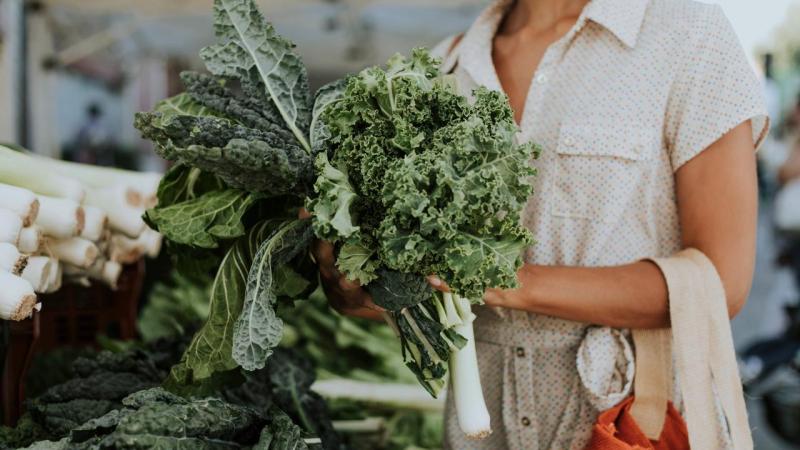Farmers markets have always offered a fantastic way to shop for fresh, flavorful produce, meats and dairy products, while supporting local suppliers. These open air markets allow you to shop whatever produce is in season — meaning you’re not only getting your fruits and veggies at their peak flavor, but you’re also able to find produce that you can’t find in standard grocery stores (such as produce that is regionally specific or that has a short shelf life).
Below are some of my tips for how to make the most of your next trip to the farmers market (provided you are lucky enough to live near one — I recognize that not everyone is that fortunate since many people across the country live in food deserts).
1 Make it a habit
Going to the same market or farm stand weekly helps you get to know the farmers and what each purveyor has to offer. I highly recommend striking up conversations and developing relationships — that way, you not only become a more educated shopper, but it’s nice for both buyer and seller to be greeted by a friendly face. If you’re in New York City, I love using the Union Square Greenmarket app, which tells you what’s in season, who has it and which days your favorite vendors will be there.
2 Plan your meals
Instead of planning to pick up the ingredients for one recipe, I try to plan for a variety of produce that will enhance my dishes and last through the week. A “handful” is a great way to measure and think about amounts — a side is a handful of raw veggies, or if you’re cooking them, two handfuls equals one serving. If I’m buying meat or fish, I’ll buy eight ounces per person, accounting for one to two-ounce trim.
3 Know what’s in season
Having some basic knowledge of which veggies are in season — and when they’re at their peak — makes you a smarter shopper and a better chef. (Here’s a seasonal produce chart for my fellow New Yorkers.) The tricky part is that even just one week can result in a difference in flavor (though I wouldn’t get too hung up on it). If you see an abundance of something, that’s a good sign that it’s in season and less expensive because the farmers have a surplus of it. The peak time for peas, for instance, is a small window in late June and early July. Sweet corn and peaches reach their peak later in the summer.
In general, the earlier in a veggie’s growth stage, the more tender it will be, and should be consumed raw or very gently cooked. Later in the growing season, that same produce is better suited for longer cooking methods.
Also, varying microclimates between farms — even in the same region — mean slightly different windows for when their produce is at its best. That’s why it helps to understand where a farm is located and develop a relationship with the farmers!
4 Start small
With veggies, often less is more. Don’t order a pound of something if you’ve never used it before. Buying a small amount of produce can help you figure out what you like and how to cook it, so that when you go back you know exactly what you want to get. With so much variety available, give yourself the goal of picking up two or three new things for your week. And ask questions! Farmers love talking about the produce and many have great recipes, cooking and preserving methods they are happy to share.
5 How to Clean Them at Home
We’ve gotten used to seeing vegetables in grocery stores looking pretty and polished. But at the farmers market, the veggies may have been picked that morning, so you might find them flecked with dirt or with their roots still intact. Don’t be deterred — those are signs of freshness!
When you get home, trim any unusable roots or tops (many leaves are usable, which you’ll learn as you begin asking questions). But don’t rinse them until the day you want to use them to avoid the risk of rot.
I suggest storing fruit and tomatoes out of the refrigerator on the counter. This means they will deteriorate quicker, but it maximizes their flavor. However, if you know you won’t get to them in a few days, there’s nothing wrong with putting them in the fridge, which helps you avoid nuisances such as fruit flies. Pickling is another great way to use up an abundance of veggies all year round.
Summer Foods — And How to Use Them:
- Kohlrabi: A member of the cabbage family, kohlrabi is a farmer favorite because it’s easy to grow. Delicious cooked or raw, you can use the leaves for a slaw or sauté them. It’s great roasted with butter and your favorite seasonings.
- Local fruit: Cherries, gooseberries, currants and stone fruit are all tasty, summery ways to get a dose of vitamin C. Simply wash and eat! If fruit starts to get a little mushy, you can always cook it down to a compote or jam and serve it with grilled meat (like pork or duck) for a delicious dish.
- Market greens: Use succulents like purslane or agretti for bursts of savory citrus flavor. Grill bitter greens, chicories or romaine then dress for a great summer salad. Branch out with unique greens, such as callaloo, popular in Carribean food and similar to sorrel or spinach — it’s great to chop up and braise.
- Edible flowers: Look for chive blossoms (use them like sliced scallions) and Egyptian carnations. Flowers elevate a dish by adding color and an extra bit of deliciousness.
- Summer squash: Flavor-wise, there are a ton of heirloom varieties, so don’t be afraid if you see a squash in a color you’re not familiar with — they cook similarly. I love preparing summer squash alla scapece — thinly slice, fry and let marinate.
Below, two recipes using two of my favorite veggies — tomatoes and sweet corn — that peak later in the summer.
Sun Gold Gazpacho
Serves 2-4
Gazpacho is a great no-cook soup for summer that offers endless variations. This version uses yellow tomatoes, pepper and melon to create a brilliant golden hue. Be sure to taste the chilled soup before you serve it as cold temperatures dull flavors.
Ingredients:
- 1 pint sun gold cherry tomatoes
- 1 aji dulce pepper or 1 tbsp harissa paste
- 1 quart yellow watermelon, seeded and diced
- 1-inch ginger, cleaned and coarsely chopped
- 2 tbsp white balsamic vinegar
- 2 tbsp extra-virgin olive oil, divided
- Espelette (or sub crushed red chili flakes), to garnish
Directions:
- Combine all ingredients and 1 tbsp olive oil in a blender on high, until gazpacho is smooth and airy.
- Taste, season as needed and chill for at least 4 hours.
- Serve with a drizzle of remaining olive oil and espelette.
Sweet Corn With Preserved Lemon Butter
Serves 4
Sweet corn is the side of summer. Peel back the husks half way to remove the corn silk, replace the husk and grill the husk on low, indirect heat. When ready to serve remove husk and eat ears with compound butter and some nice finishing salt.
Ingredients:
- 1/4 lb unsalted butter, room temperature
- 1 tbsp preserved lemon, chopped
- 1 garlic clove, grated
- 1 tsp kosher salt
- 1/4 tsp black pepper
- 1 sprig rosemary, cleaned and chopped
- 1 sprig thyme, cleaned
- 4 ears fresh sweet corn, husked
Directions:
- Combine butter with lemon and seasonings using an immersion blender, then spread mixture in a small pan.
- Grill corn on low, indirect heat until cooked, about 20 minutes.
- Roll each ear in butter mixture while the kernels are still warm.
Originally Published by THE WELL

